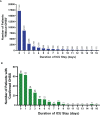Ovarian Hyperstimulation Syndrome (OHSS) requiring Intensive Care Unit (ICU) admission between 1996-2020 in England, Wales, and Northern Ireland
- PMID: 36589797
- PMCID: PMC9797661
- DOI: 10.3389/fendo.2022.1060173
Ovarian Hyperstimulation Syndrome (OHSS) requiring Intensive Care Unit (ICU) admission between 1996-2020 in England, Wales, and Northern Ireland
Abstract
Introduction: Ovarian Hyperstimulation Syndrome (OHSS) is a life-threatening iatrogenic complication of In vitro fertilisation (IVF). This study aimed to quantify rates of Ovarian Hyperstimulation Syndrome (OHSS) requiring intensive care unit (ICU) admission and assess whether trends have changed between 1996-2020 commensurate with the introduction of safer IVF practices.
Methods: Data regarding Intensive Care Unit (ICU) admission across England, Wales and Northern Ireland was gathered retrospectively from the Intensive Care National Audit and Research Centre (ICNARC) database. 38,957 female patients aged between 18-55 years were admitted to ICU for OHSS or related conditions between 1996-2020. The primary outcome was the rate of OHSS requiring ICU admission expressed as a proportion of the number of fresh IVF cycles conducted in that year according to Human Fertility and Embryology Authority (HFEA) records. Baseline characteristics (for example, age, ethnicity, BMI), biochemical parameters (such as renal function, serum electrolytes), length of ICU stay and duration and need for organ support, were also compared between ICU patients with 'confirmed OHSS' and those 'without OHSS'.
Results: There were 238 cases of 'confirmed OHSS' requiring ICU admission recorded between 1996-2020. Rates of OHSS requiring ICU admission declined over the study period (P=0.006); the annual rate of severe OHSS requiring intensive care admission halved when comparing those occurring between 1996-2007 and 2008-2020 (OR=0.37, 95% CI 0.37-0.45; P<0.0001). Patients spent a mean of 3.5 days in the ICU, with 86.3% of patients with 'confirmed OHSS' requiring at least 2 days of higher level (i.e., level 2 or 3) care. Patients with 'confirmed OHSS' required a shorter duration of renal, advanced cardiovascular, and advanced respiratory support than patients 'without OHSS' (P<0.0001 for all comparisons). There was no significant difference in BMI or ethnicity between those with 'confirmed OHSS' and those 'without OHSS', however women with 'confirmed OHSS' were younger (34 versus 41 years old, p<0.0001).
Discussion: Although absolute rates of OHSS requiring ICU admission recorded in this study are likely to represent a significant underestimate of all clinically significant OHSS, rates of OHSS requiring ICU admission have decreased since 1996 in concordance with the introduction of modern IVF practices.
Keywords: In Vitro Fertilization (IVF); Intensive Care Unit (ICU); Ovarian Hyperstimulation Syndrome (OHSS); rates; severe OHSS.
Copyright © 2022 Abbara, Patel, Parekh, Garg, Jayasena, Comninos and Dhillo.
Conflict of interest statement
The authors declare that the research was conducted in the absence of any commercial or financial relationships that could be construed as a potential conflict of interest.
Figures



Similar articles
-
Risk of severe ovarian hyperstimulation syndrome in GnRH antagonist versus GnRH agonist protocol: RCT including 1050 first IVF/ICSI cycles.Hum Reprod. 2016 Jun;31(6):1253-64. doi: 10.1093/humrep/dew051. Epub 2016 Apr 8. Hum Reprod. 2016. PMID: 27060174 Clinical Trial.
-
Case mix, outcome and activity for patients admitted to intensive care units requiring chronic renal dialysis: a secondary analysis of the ICNARC Case Mix Programme Database.Crit Care. 2007;11(2):R50. doi: 10.1186/cc5785. Crit Care. 2007. PMID: 17451605 Free PMC article.
-
Consistent high clinical pregnancy rates and low ovarian hyperstimulation syndrome rates in high-risk patients after GnRH agonist triggering and modified luteal support: a retrospective multicentre study.Hum Reprod. 2013 Sep;28(9):2529-36. doi: 10.1093/humrep/det304. Epub 2013 Jul 19. Hum Reprod. 2013. PMID: 23873146
-
Monitoring of stimulated cycles in assisted reproduction (IVF and ICSI).Cochrane Database Syst Rev. 2021 Apr 12;4(4):CD005289. doi: 10.1002/14651858.CD005289.pub4. Cochrane Database Syst Rev. 2021. PMID: 33844275 Free PMC article.
-
Ovarian hyperstimulation syndrome: review and new classification criteria for reporting in clinical trials.Hum Reprod. 2016 Sep;31(9):1997-2004. doi: 10.1093/humrep/dew149. Epub 2016 Jun 23. Hum Reprod. 2016. PMID: 27343272 Review.
Cited by
-
Effect of aromatase inhibitors for preventing ovarian hyperstimulation syndrome in infertile patients undergoing in vitro fertilization: a systematic review and meta-analysis.Reprod Biol Endocrinol. 2024 Jul 23;22(1):85. doi: 10.1186/s12958-024-01258-y. Reprod Biol Endocrinol. 2024. PMID: 39044268 Free PMC article.
References
-
- Royal College of Obstetricians & Gynaecologists . The management of ovarian hyperstimulation syndrome. Available at: https://www.rcog.org.uk/guidance/browse-all-guidance/green-top-guideline... (Accessed Jun 21, 2022).
-
- Abbara A, Jayasena CN, Christopoulos G, Narayanaswamy S, Izzi-Engbeaya C, Nijher GMK, et al. . Efficacy of kisspeptin-54 to trigger oocyte maturation in women at high risk of ovarian hyperstimulation syndrome (OHSS) during In vitro fertilization (IVF) therapy. J Clin Endocrinol Metab (2015) 100(9):3322–31. doi: 10.1210/jc.2015-2332 - DOI - PMC - PubMed
Publication types
MeSH terms
Grants and funding
LinkOut - more resources
Full Text Sources

